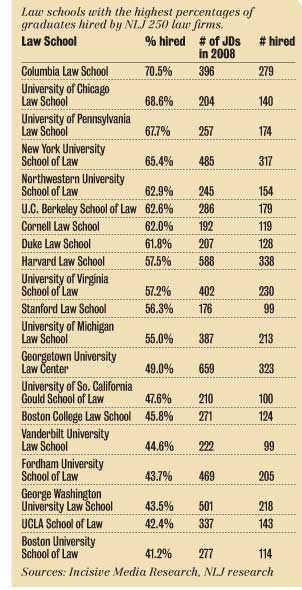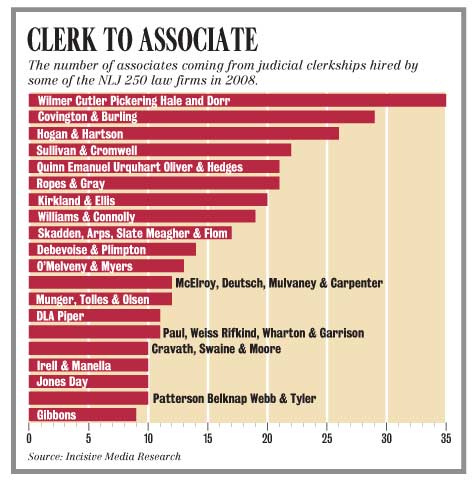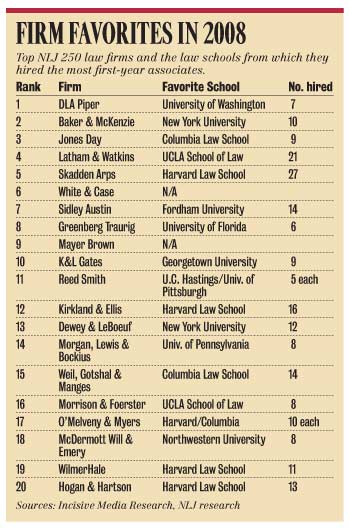Despite the economic nosedive that began gaining momentum in 2008, the nation’s biggest law firms hired just about the same percentage of graduates from top schools last year as they did the year before.
At the same time, firms among The National Law Journal‘s 2008 survey of the nation’s 250 largest law firms brought aboard more graduates from the 20 schools that they relied on the most, which themselves had larger classes.
The development suggests that law firms were not well-positioned for the recession they now face. It also suggests that although firms relied on the most prestigious schools to about the same degree in 2008, they pulled back their recruiting at schools outside the top 20.

Some 54.6% of students graduating from the 20 law schools recruited most heavily by NLJ 250 firms accepted positions as first-year associates in 2008, a nominal decline from the 2007 figure of 54.9%.
Also in 2008, NLJ 250 law firms hired 5.3% more graduates from those 20 law schools that they relied on the most. Those law schools sent 3,696 of their total 6,771 juris doctor graduates to NLJ 250 firms. The top 20 schools in 2007 sent 3,511 of their total 6,395 juris doctor graduates to NLJ 250 firms.
Once again, Columbia Law School took the No. 1 spot as the school sending the highest percentage of its graduates directly to NLJ 250 firms. Among its 396 juris doctor graduates in 2008, 70.5% went to NLJ 250 law firms. In 2007, Columbia Law School sent 74.8% of its graduates to NLJ 250 law firms, and in 2006, 69.9% of the school’s students joined NLJ 250 firms directly after graduation.
The list of the 20 law schools whose students were recruited most heavily by NLJ 250 firms was compiled from recruiting information that firms provided on the 2008 NLJ 250 survey. This is the third year that the NLJ has compiled this list of go-to schools. In 2006, those schools sent 51.6% of their graduates directly to NLJ 250 firms. [See last year's law schools report.]
Boston University School of Law rounded out the list of the top 20 go-to law schools, with 41.2% of its graduates taking jobs at NLJ 250 law firms.
Strains in hiring system
The fact that law firms ended up hiring the same percentage of graduates in 2008 — and hired 5.3% more graduates than in 2007 — despite the impending economic turmoil demonstrates the challenges that law firms face in predicting their work force needs under the existing hiring system. Most first-year associates at large firms come from the pool of summer associates who interview with the firms two years before their working start dates.
Bill Henderson, a professor at Indiana University Maurer School of Law — Bloomington who studies law firms, said the current economic problems should force big law firms to rethink the traditional hiring model.
But change is slow.
“It’s hard to steer a big ocean liner,” he said.
Henderson, who views the summer-to-full-time-associate model as “fundamentally flawed,” expects that pressure for change will come from the students themselves, who are not interested in taking jobs at big firms only to leave after a couple of years.
“They want firms looking to hire associates who can actually stay with them,” he said.
Of late, however, attrition has not been the problem for law firms. Rather, they now find that they have too many hands on deck. On a single day, Feb. 12, large law firms laid off more than 700 attorneys and legal staffers because of declines in business. Firms that interviewed law students in 2006 for summer associate positions and hired those people full time in 2008 have discovered their ranks bloated amid the downturn.
“They need a more sustainable model,” Henderson said.
 The go-to school list does not account for students taking judicial clerkships after graduation rather than joining law firms. This year, The National Law Journal tracked the number of judicial clerks whom law firms hired as associates. Topping the list with the most clerks hired was Wilmer Cutler Pickering Hale and Dorr, which brought aboard 35 associates from judicial clerkships.
The go-to school list does not account for students taking judicial clerkships after graduation rather than joining law firms. This year, The National Law Journal tracked the number of judicial clerks whom law firms hired as associates. Topping the list with the most clerks hired was Wilmer Cutler Pickering Hale and Dorr, which brought aboard 35 associates from judicial clerkships.
Falling off this year’s go-to list was Yale Law School, which ranked No. 20 last year, when 38.5% of its 2007 graduates — or 72 people — took jobs at NLJ 250 law firms. Yale’s disappearance from the list was due in large part to the percentage of students who took judicial clerkships after graduation. Approximately 40% of Yale’s graduating class each year goes directly to a clerkship, said Janet Conroy, the school’s director of public relations. About 35% of Yale graduates each year go directly to law firms.
New to this year’s list was Fordham University School of Law, which sent 43.7% — or 205 of its 469 J.D. graduates — to NLJ 250 law firms. It came in at No. 17.
The law school, located in New York City, has recast its strategy to target large law firms in its placement efforts, said William Treanor, dean of the school.
“We have very much focused on a concerted effort for firms to hire our graduates,” Treanor said.
The law school has worked to bolster contacts with its alums who practice in large firms, and its leaders have met with managing partners to learn more about what they want from graduates, Treanor said.
Making big jumps this year in their positions among the top 20 go-to schools were Boston College Law School, ranked No. 15 this year and No. 20 last year, and the University of California, Berkeley School of Law, which was No. 6 this year compared with No. 11 last year. Boston College Law School sent 45.8% of its 2008 graduates to NLJ 250 firms, compared with 36.8% of its 2007 graduates. Some 62.6% of U.C. Berkeley’s 2008 graduates took jobs at NLJ 250 firms, compared with 53.7% of its 2007 graduates.

Playing favorites
Several top law firms showed a penchant for certain schools in their recruiting. For example, Harvard Law School was a big favorite for New York-based Skadden, Arps, Slate, Meagher & Flom; it recruited 27 of its first-year associates from Harvard. Chicago-based Kirkland & Ellis also recruited heavily from Harvard, bringing aboard 16 from the school, as did Washington-based Hogan & Hartson, which hired 13 Harvard graduates. O’Melveny & Myers hired 10 graduates from the school.
University of California at Los Angeles School of Law was a favorite of Latham & Watkins, which recruited 21 associates from that school. The nation’s largest law firm, DLA Piper, saw its highest concentration of first-year associates from University of Washington School of Law. Sidley Austin showed a preference for Fordham University School of Law, which provided the firm with 14 first-year associates. Baker & McKenzie and New York-based Dewey & LeBoeuf were popular destinations for New York University School of Law graduates. Baker & McKenzie brought on 10 graduates from there, and Dewey & LeBoeuf hired 12. Columbia Law School was a favorite of New York-based Weil, Gotshal & Manges, which recruited 14 of its graduates; O’Melveny & Myers, which hired 10; and Jones Day, which gave jobs to nine.
NLJ VIDEO: Associate editor Leigh Jones talks about the research that went into this year’s Law Schools Report.




